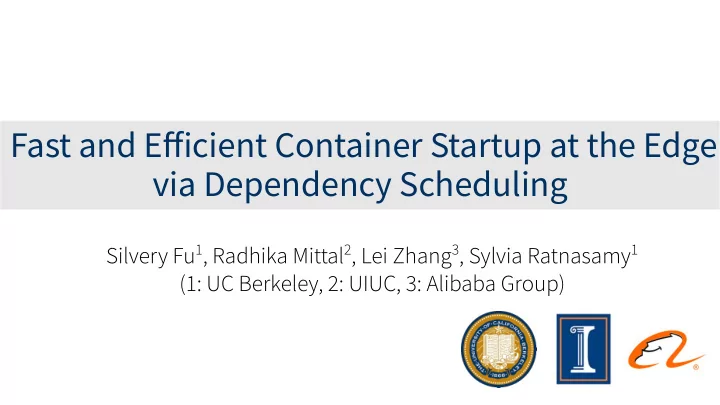

Fast and Efficient Container Startup at the Edge via Dependency Scheduling Silvery Fu 1 , Radhika Mittal 2 , Lei Zhang 3 , Sylvia Ratnasamy 1 (1: UC Berkeley, 2: UIUC, 3: Alibaba Group)
Container Technologies are Popular • Adopted in 2,000+ companies • 160+ million container images • 86% of containers are deployed on kubernetes • Emerging frameworks and use cases in edge computing
Slow Start Transfer container image - fetch image from a repository Decompress and set up T: task time; S: startup time; R: running time - T = S + R; S ∝ R Short tasks suffer!
Startup Latency • Profile dependency pulling: - Trace: 56k, 33TB images - Amazon ECR, m4.xlarge - Average image pulling latency is 19.2 seconds • An image includes all container dependencies, including binaries, code, configurations files.
Cloud experiment with Deploying Containers high-speed networks and powerful machines! Can we make container start faster in an easily- >20s adoptable way? < 1s < 100ms Booting Latency Trace: 56k, 33TB images Amazon EC2 Scheduling latency Pulling Latency
Can we avoid pulling images?
Design 1: Image-aware Placement Image Matching • Issues: - binary decision - image name changes
Can we do better than matching image?
Layer View • Layers are shared across images! A layer digest is content-addressable
Design 2: Layer-aware Placement image: image: alphabet alpha Layer Matching image: omega image: theta image: alphabet
Are the required changes easily adoptable?
k8s layer-aware Master Node Scheduler Image resolution + Better performance Dependency Scheduling - More API changes API Server CLI - More overhead etcd Layer Info Kubelet Kubelet Worker Node Worker Node Layer Tracking Layer Tracking Local Local Container Container Image Image Runtime Runtime Store Store External Image Store
Results
Faster Startup • Setup: 200 nodes - 32GB image storage - 80% utilization - Zipf distribution - • Improvements on avg. startup latency: 1.4x smaller (image) - 2.3x smaller (layer) -
Resource Efficiency • Smaller compute usage: 1.3x (image) and 2x (layer) • More spare storage (excluding container images): ○ 1.1x (image) and 1.6x (layer)
Open questions - in real-world? (..need categorization of edge workloads) - What are the implications of resource efficiency gains and startup latency reductions? - What are the (other) forms of data locality issues at the edge?
Open questions System-wise: - How to balance dep. scheduling and the other scheduling policies? - How much overhead (e.g., on the node-master communication, the apiserver,)? - ..
Summary • Containers and container images are the emerging tools to facilitate sofuware reuse in deployment. • Such reuse can lead to substantial dependency sharing between containers. • Dependency-aware scheduling exploits such sharing, and is highly effective in cutting container startup latency.
Thank you! silvery@eecs.berkeley.edu
Recommend
More recommend